Impact of concomitant medication on clinical outcomes in patients with advanced non-small cell lung cancer treated with immune checkpoint inhibitors: A retrospective study
- PMID: 33990133
- PMCID: PMC8258365
- DOI: 10.1111/1759-7714.14001
Impact of concomitant medication on clinical outcomes in patients with advanced non-small cell lung cancer treated with immune checkpoint inhibitors: A retrospective study
Abstract
Background: It has recently been suggested that concomitant medication may affect the clinical outcome of patients treated with immune checkpoint inhibitors (ICIs). However, only a few studies on the impact of concomitant medication on immune-related adverse events (irAEs) have previously been reported. Here, we aimed to determine the impact of concomitant medication on the efficacy and safety of ICIs.
Methods: We retrospectively analyzed the data of 300 patients treated with nivolumab or pembrolizumab for advanced non-small cell lung cancer (NSCLC) between January 2016 and July 2018. Multivariate logistic regression analysis was used to assess the effect of concomitant medication on treatment response or irAEs. A multivariate Cox proportional hazards model was used to evaluate concomitant medication-related factors associated with time-to-treatment failure or overall survival (OS).
Results: A total of 70 patients responded to treatment and 137 experienced irAEs. The response rate and incidence of irAEs in patients treated with ICIs were not significantly associated with concomitant medication. Multivariate analysis showed that the use of opioids was an independent factor (time-to-treatment failure: hazard ratio 1.39, p = 0.021, OS: hazard ratio 1.54, p = 0.007).
Conclusions: The efficacy and safety of nivolumab or pembrolizumab in the treatment of patients with advanced NSCLC were not significantly influenced by concomitant medication. However, opioid usage might be associated with shorter OS in patients treated with these ICIs. Further mechanistic investigations should explore whether these associations are purely prognostic or contribute to ICI resistance.
Keywords: concomitant medication; immune checkpoint inhibitors; immune-related adverse events; non-small cell lung cancer; opioids.
© 2021 The Authors. Thoracic Cancer published by China Lung Oncology Group and John Wiley & Sons Australia, Ltd.
Conflict of interest statement
The authors declare that they have no competing interests.
Figures


Similar articles
-
Peripheral Blood Markers Identify Risk of Immune-Related Toxicity in Advanced Non-Small Cell Lung Cancer Treated with Immune-Checkpoint Inhibitors.Oncologist. 2019 Aug;24(8):1128-1136. doi: 10.1634/theoncologist.2018-0563. Epub 2019 Apr 23. Oncologist. 2019. PMID: 31015312 Free PMC article.
-
Association Between Immune-related Adverse Events and Efficacy of Immune Checkpoint Inhibitors in Non-small-cell Lung Cancer.Clin Lung Cancer. 2019 May;20(3):201-207. doi: 10.1016/j.cllc.2018.10.002. Epub 2018 Oct 11. Clin Lung Cancer. 2019. PMID: 30442524
-
Profiling Preexisting Antibodies in Patients Treated With Anti-PD-1 Therapy for Advanced Non-Small Cell Lung Cancer.JAMA Oncol. 2019 Mar 1;5(3):376-383. doi: 10.1001/jamaoncol.2018.5860. JAMA Oncol. 2019. PMID: 30589930 Free PMC article.
-
Immune checkpoint inhibitors of the PD-1/PD-L1-axis in non-small cell lung cancer: promise, controversies and ambiguities in the novel treatment paradigm.Scand J Clin Lab Invest. 2020 Sep;80(5):360-369. doi: 10.1080/00365513.2020.1742369. Epub 2020 Apr 2. Scand J Clin Lab Invest. 2020. PMID: 32238062 Review.
-
Association of immune-related adverse events and efficacy in advanced non-small-cell lung cancer: a systematic review and meta-analysis.Immunotherapy. 2023 Feb;15(3):209-220. doi: 10.2217/imt-2022-0028. Epub 2023 Jan 30. Immunotherapy. 2023. PMID: 36710655
Cited by
-
The Association between Baseline Proton Pump Inhibitors, Immune Checkpoint Inhibitors, and Chemotherapy: A Systematic Review with Network Meta-Analysis.Cancers (Basel). 2022 Dec 31;15(1):284. doi: 10.3390/cancers15010284. Cancers (Basel). 2022. PMID: 36612290 Free PMC article. Review.
-
The negative impact of opioids on cancer patients treated with immune checkpoint inhibitors: a systematic review and meta-analysis.J Cancer Res Clin Oncol. 2023 Jun;149(6):2699-2708. doi: 10.1007/s00432-022-04513-0. Epub 2022 Dec 20. J Cancer Res Clin Oncol. 2023. PMID: 36538147 Free PMC article.
-
Adverse reactions of immune checkpoint inhibitors combined with Proton pump inhibitors: a pharmacovigilance analysis of drug-drug interactions.BMC Cancer. 2024 Sep 27;24(1):1193. doi: 10.1186/s12885-024-12947-7. BMC Cancer. 2024. PMID: 39334098 Free PMC article.
-
Immune Checkpoint Inhibitors and Opioids in Patients with Solid Tumours: Is Their Association Safe? A Systematic Literature Review.Healthcare (Basel). 2022 Dec 30;11(1):116. doi: 10.3390/healthcare11010116. Healthcare (Basel). 2022. PMID: 36611575 Free PMC article. Review.
-
Prognostic Value of Baseline Medications Plus Neutrophil-to-Lymphocyte Ratio in the Effectiveness of Nivolumab and Pembrolizumab in Patients With Advanced Non-Small-Cell Lung Cancer: A Retrospective Study.Front Oncol. 2021 Nov 8;11:770268. doi: 10.3389/fonc.2021.770268. eCollection 2021. Front Oncol. 2021. PMID: 34820333 Free PMC article.
References
-
- Siegel RL, Miller KD, Jemal A. Cancer statistics, 2019. CA Cancer J Clin. 2019;69:7–34. - PubMed
-
- Oken MM, Creech RH, Tormey DC, Horton J, Davis TE, ET MF, et al. Toxicity and response criteria of the eastern cooperative oncology group. Am J Clin Oncol. 1982;5:649–55. - PubMed
-
- Califano R, Lal R, Lewanski C, Nicolson MC, Ottensmeier CH, Popat S, et al. Patient selection for anti‐PD‐1/PD‐L1 therapy in advanced non‐small cell lung cancer: implications for clinical practice. Future Oncol. 2018;14:2415–31. - PubMed
MeSH terms
Substances
LinkOut - more resources
Full Text Sources
Other Literature Sources
Medical

